You are here
Laboratory of Mathematical Methods of Image Processing
Head of the laboratory: Krylov Andrey, Professor, Dr.Sc.
The Laboratory was established in June, 2007 at the Faculty of Computational Mathematics and Cybernetics, the Department of Mathematical Physics. The main scientific research areas are the following: mathematical methods of image/video/audio processing; computer signal processing.
Staff members:
- Nasonov Andrey, Senior Research Fellow, PhD
- Yatchenko Artem, Research Fellow, PhD
- Lukshina Elena, Engineer
- Sitdikov Iskander, Laboratory Assistant
Regular courses:
- Mathematical Methods of Image Processing by Prof. Krylov, 32 lecture hours, 6th semester.
Special courses:
- Integral Transforms in Image Processing by Prof. Krylov and Dr. Lukin, 32 lecture hours, 5th semester.
- Computational Methods of Image Processing by Prof. Krylov, 32 lecture hours, 8th semester.
Special seminar
Image processing and computer modeling by Prof. Krylov, Dr. Mizotin, Dr.Yurin, Dr. Nasonov
Main Scientific directions
Image processing (Prof. A.S. Krylov, Dr. A.S. Lukin, and Dr. A.V. Nasonov)
The team of the Laboratory develops scientific areas connected with mathematical methods and algorithms of image processing. The main research topics can be divided into the following groups:
Reconstruction of a high-resolution image from a low-resolution image is a general problem in image processing. The research is performed in two directions:
- reconstruction of a high-resolution image as a solution of an ill-posed inverse problem of resampling a low-resolution image from a high-resolution one; this approach uses regularization methods;
- low-complexity image interpolation algorithms for the realtime video conversion; fast edge-directional resizing algorithms image and video are developed.
Existence of several low-resolution images of the same source can provide a better quality of the restored high-resolution image. The reconstructing process of a single high-resolution image from several low-resolution observations is called as superresolution.
This project encompasses three directions:
- the high-quality superresolution based on regularization methods;
- the non-iterative superresolution; a method of weighted median averaging is used to combine pixel values of given low-resolution images;
- superresolution for video sequences; two images are used here for high-resolution frame construction: the current low-resolution frame and the preceding high-resolution frame.
Application of regularization methods for image enhancement:
- for its deblurring,
- for its deringing and
- for denoising.
Image analysis (Prof. A.S. Krylov, Dr. A.V. Nasonov, Dr. M.M. Mizotin)
Presently the main research topics of the Laboratory in the area of mathematical methods’ application in image analysis are:
The development of quality metrics for resampled and enhanced images. Image metrics are used to objectively compare two images. We consider the problem of evaluating image enhancement algorithms like resampling, deringing, deblurring. The main idea is to find the areas where typical artifacts of image enhancement algorithms usually appear: blur and ringing artifacts.
Keypoints detection and local image descriptors construction is one of the basic problems in image analysis.
The keypoints detection and descriptors construction algorithms are based on Gauss-Laguerre circular harmonic functions (CHFs) image expansion. The interconnection between Gauss-Laguerre CHFs and 2D Hermite functions in conjunction with the fast Hermite projection method is used to accelerate the computation.
The subjects of the current research are the following:
- an improvement of stability of Gauss-Laguerre keypoints descriptors to a class of projective and photometric transformations;
- extension of the keypoints detection and descriptors construction for color images.
Medical image processing is one of the most important areas where the progressive development allows reaching vitally essential results and the application of mathematical methods is actually required in practice.
As an example, the Laboratory’s staff develops the algorithms of eye fundus image analysis that is preformed in cooperation with the Department of Ophthalmology of the Faculty of Fundamental Medicine, MSU. The work implies the development of the automated system of eye fundus image processing that is designed to assist an ophthalmologist in his diagnostics.
The main steps of analysis and processing are:
- image preprocessing;
- detection of structural elements: optical disc, macula, blood vessels;
- detection of exudates;
- blood vessels analysis.
The Laboratory’s team performs various researches in the area of medical image processing. The examples are the following:
- the development of regularization methods for the suppression of aliasing in ultrasound Doppler images (the information in each image pixel is a set modulo 2π);
- analysis of magnetic resonance images of a damaged brain etc.
Biometrical technologies are actively used in many areas to ensure the information access protection and to solve the problem of personal identification. One of personal identification methods is the iris identification. Iris recognition is a very reliable method of personal identification as the iris is unique for each person and doesn’t alter through one’s lifetime. The human identification by iris recognition is more reasonable than by finger-prints or the face detection because the iris image is more random than faces or fingerprints.
In our work, Hermite projection methods are used for the human iris identification. An expansion of the iris intensity information into a series of eigenfunctions of the Fourier transform enables us to perform an information analysis of the signal and its Fourier transform at the same time. Also these methods are robust to information errors. Effectiveness of the methods with test iris images database has been demonstrated.
General mathematical methods developed in the Laboratory are used in audio signal processing. The examples of audio processing tasks are the following:
- audio noise reduction;
- multiresolution analysis and processing of audio signals.
Audio signals can be converted to a 2D representation — spectrogram — by a Short-Time Fourier Transform (STFT).
Many image processing methods can be applied to spectrograms for the purposes of noise reduction, instrument extraction, and identification. Multiresolution methods can improve the precision of a spectrogram analysis and reduce artifacts of a typical STFT processing, like ringing or energy smearing.
Some of the obtained results are published in:
- A.S.Krylov and M.M.Mizotin, Projection method for the Hankel transform // Integral Transforms and Special Functions, vol. 22, no. 6, pp. 431−441, June 2011.
- A.V.Nasonov and A.S.Krylov, Finding areas of typical artifacts of image enhancement methods // Pattern Recogn. and Image Anal., vol. 21, no. 2, pp. 316-318, 2011.
- D.V.Sorokin and A.S.Krylov, Gauss-Laguerre-Hermite method of keypoint extraction // Pattern Recogn. and Image Anal., vol. 2, no. 21, pp. 332-334, 2011.
- D.V.Sorokin, M.M.Mizotin and A.S.Krylov, Gauss-Laguerre keypoints extraction using fast Hermite projection method // In: Int. Conference on Image Analysis and Recognition (ICIAR2011), LNCS, Burnaby, BC, Canada, vol. 6753, pp. 284−293, June 2011.
- A.S.Krylov and D.V.Sorokin, Gauss-Laguerre keypoints descriptors for color images // Image Analysis and Recognition. Lecture Notes in Computer Science. Berlin: Springer, no. 6753, pp. 284-293, 2011.
- A.S.Krylov and A.V.Nasonov, Edge-directed image interpolation using color gradient information // 16th International Conference on Image Analysis and Processing (ICIAP'2011), Lecture Notes in Computer Science, vol. 6979, part 2, pp. 40−49, 2011.
- A.S.Semashko, A.S.Krylov and A.S.Rodin, Using blood vessels location information in optic disk segmentation // 16th Int. Conference on Image Analysis and Processing (ICIAP'2011), Lecture Notes in Computer Science, vol. 6979, part 2, pp. 384−393, 2011.
- S.Stankovic, I.Orovic and A.S.Krylov, The two-dimensional Hermite S-method for high resolution ISAR imaging applications // IET Signal Processing, vol. 4, no. 4, pp. 352-362, 2010.
- S.Stankovic, I.Orovic and A.Krylov, Video frames reconstruction based on time-frequency analysis and Hermite projection method // EURASIP Journal on Advances in Signal Processing, vol. 2010, pp. 6:1−6:11, February 2010.
- A.V.Nasonov and A.S.Krylov, Fast super-resolution using weighted median filtering // Proc. Intern. Conf. on Pattern Recognition. Istanbul, Turkey: IEEE Computer Society Press, pp. 2230-2233, 2010.
- A.V.Nasonov and A.S.Krylov, Scale-space method of image ringing estimation // In: Proceedings of International Conference on Image Processing (ICIP09). Cairo, Egypt, pp. 2794−2797, 2009.
- A.S.Krylov and A.V.Nasonov, Adaptive image deblurring with ringing control // In: Fifth International Conference on Image and Graphics (ICIG 09). Xian, Shanxi, China, pp. 72−75, 2009.
- A.S.Krylov, A.S.Lukin and A.V.Nasonov, Edge-preserving nonlinear iterative image resampling method // In: Proceedings of International Conference on Image Processing (ICIP09). Cairo, Egypt, pp. 385−388, 2009.
- N.Lyubimov and A.Lukin, Audio Bandwidth Extension using Cluster Weighted Modeling of Spectral Envelopes // In: 127th Audio Engineering Society Convention. New-York, USA, paper no. 7946, October 2009.
More detailed information on the Laboratory, its research areas, publications and activities can be found at the website: http://imaging.cs.msu.ru/.



